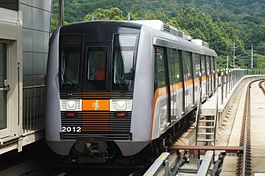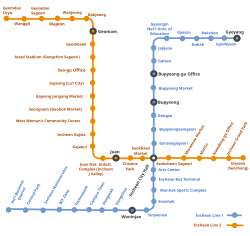You can help expand this article with text translated from the corresponding article in Korean. (September 2022) Click [show] for important translation instructions.
|
Incheon Subway Line 2 is a driverless, medium-capacity subway line running 29.2 km (18.1 mi) from Oryu-dong in Seo-gu to Incheon Grand Park, with 27 stations,[1] part of the Incheon Subway system. The line is also included as a part of the overall Seoul Metropolitan Subway network; Juan station has a free transfer with Seoul Subway Line 1, Geomam station connects with the AREX Line to Incheon International Airport and Seoul Station, and Seongnam also has a free transfer with Seoul Subway Line 7.
| Incheon Line 2 | |||
|---|---|---|---|
 | |||
| Overview | |||
| Status | Operational | ||
| Termini |
| ||
| Stations | 27 | ||
| Service | |||
| Type | Rapid transit | ||
| System | Incheon Subway | ||
| Operator(s) | Incheon Transit Corporation | ||
| Depot(s) | Unyeon | ||
| History | |||
| Opened | July 30, 2016 | ||
| Technical | |||
| Line length | 29.2 km (18.1 mi) | ||
| Number of tracks | 2 | ||
| Electrification | 750 V DC third rail | ||
| |||
Line 2 has aboveground sections north of Asiad Stadium and east of Namdong-gu Office.
History edit
- June 26, 2009: Construction begins. The price of building the line was 2 trillion KRW.
- Early 2016: Trial runs begin.
- July 30, 2016: The line opens, after seven years of construction.[2][3]
Line 2 was planned to open in August 2014,[4] but the opening date was pushed back to July 30, 2016.
Rolling stock and signaling edit
The ITC Line2 is a driverless, fully automatic subway system. The line uses 37 two-car trains, all of which were built in 2013 by Hyundai Rotem, a member of Hyundai Motor Group.[4][5] They are similar to the Canada Line cars in Vancouver, Canada, albeit using the narrow light metro body (2.65 m (8 ft 8 in)) and external sliding doors as opposed to the heavy metro wide body 3 m (9 ft 10 in) and pocket doors, and using a bottom contact third rail instead of the North American top contact.
Currently, all stations are long enough to fit four-car trains (two sets mated together); however, current operations use two-car trains (one set per train).
SelTrac CBTC is currently being implemented on the line by Thales, along with an urban rail traffic management system; these systems will allow the trains to be driverless.[2]
Stations edit
All stations are in Incheon.
See also edit
External links edit

References edit
- ^ "General information". Incheon Transit Corporation. Archived from the original on 2015-09-24. Retrieved 2017-01-13.
- ^ a b http://world.kbs.co.kr/english/news/news_Dm_detail.htm?No=120751%7C title = Opening Ceremony Held for Incheon Subway Line No. 2
- ^ 최, 미경 (June 22, 2012). "인천시의회, 하루 만에 뒤집다" (in Korean). Kiho News. Retrieved 2012-06-25.
- ^ a b "Incheon metro Line 2 signalling contract awarded". Railway Gazette International. February 9, 2010. Archived from the original on July 15, 2011.
- ^ The specification of the cars of Incheon Subway Line 2 Archived 2011-07-11 at the Wayback Machine
- ^ This sounds "Lu-One City"
- ^ "사업소개" (in Korean). 도시철도건설본부. Archived from the original on 2013-01-11. Retrieved 2012-06-07.



